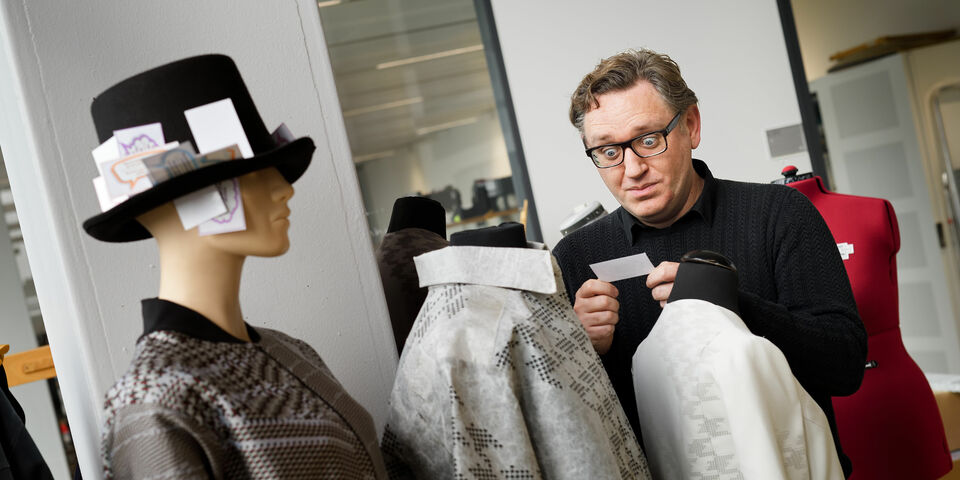The Hot Seat | “I want to change how fashion is made”
Troy Nachtigall (41) is a PhD in the department of Industrial Design. With his research on ultra personalized product service systems he aims to design personalized shoes. Having a background in fashion working for Hugo Boss and Calvin Klein in Florence, he knows how to combine style and technology. Of course Cursor’s silk hat is a timeless classic. Troy picks five questions and manages to relate them all to fashion and design.
Does coincidence really exist?
“Of course it does. If there was no coincidence, what would we be doing here? Coincidence is where you find the magic. The first rule of design is to explore the design space and call out serendipity. It’s often the small things that don’t fit in the system that make the design. In the everyday life where people use the things we make, things rarely happen for the reasons we planned them to. If you’re a good designer you consider all kinds of outcomes, pull the strings behind the curtain and look for the coincidences. Bill Buxton says, and it’s a really great quote: ‘Design is everything that’s obvious before it’s obvious.’ It’s about finding those obvious things before everybody else realizes them.”
Which book is a must-read?
“That would be ‘The stuff of bits’ by Paul Dourish. It’s about how data is a material, a material you can design. Really a fascinating essay on how we make things with data and how data can make things. Data has a physical form, whether it’s on a cd, harddrive or printed on paper. But there is this figurative form to data most people don’t think about. If we take the next step and acknowledge that data itself is a thing, we change the design and change how we make things. Industrial Design and this university are leading a worldwide change into making things with data. Whether they are shoes, drones or self-driving vehicles: they all use data as a material.”
Did you ever steal anything and if so, what?
“To quote Picasso: “Good artists borrow, great artists steal.” As a fashion designer I stole a lot of ideas. I think that in fashion design it’s just the rule of the game and the practise of the trade. Stealing, remixing and abstracting is the point. The hardest part of becoming a PhD student and coming back to academia was learning to cite everybody’s ideas. I became much more aware of giving credit where it’s due. In science the rules are very strict concerning citation. And I understand: you’re building on the backs of others and citing their ideas is a form of respect.”
(Read on below the picture)
Who is most dear to you and why?
“My wife. She’s the one who convinced me to do this PhD. I would have continued to work as a fashion designer had I not been told that my fashion ideas didn’t work half the time because I was too far ahead. I needed a place to really work on those ideas. So back in Florence, I came home one day saying I might have an opportunity for a PhD in Eindhoven. Shortly after, she mentioned she found a job in Waalwijk (city close to Eindhoven, ed.). ‘Come as soon as you can.’ She never let’s me settle but motivates me to take things to the next level all the time.”
What would you like to be most famous for?
"I would like to change how fashion is made. There are big problems with sustainability. Fashion is the second largest polluting industry, after agriculture. People are talking about not using straws when they’re sitting there in an outfit that’s entirely made out of plastic?! If you throw a straw in the bin, it will stay a straw in the ground for the next 500.000 years. The plastic clothes are getting washed every day, turn into microbeads, are digested by fish and entirely break down our ecosystem. So I want to change how we make clothing so we can deal with those problems.
I think we have seen so many other things change rapidly in the age we’re living in. We used to buy things in stores and now there’s this thing called Amazon. The influence of the internet has changed so many industries. It changed how much we buy and how easy we buy. We see an explosion in consumption. Back in the days we industrial designers invented the washing machine to take away the hard labor. So, yes people have more time and washing your clothes is less work now. But people also started to buy more and more clothes, at approximately the same time we started to use more and more plastics in clothes. So things we make to improve an industry often create much larger problems.
Now 3D printed shoes won’t make you buy less shoes. But if you 3D print shoes and use data in them, the data can help you decide on ‘Do I need a new pair of shoes? Has the material worn out?’ Then you can still argue; ‘Do you buy new shoes based on needs or wants?’ Well, we calculated that you need about 180 pairs of shoes in an average lifetime. The average European owns 360 pairs, an American 720. So our needs and our consumption are in no way matching. What I want to do is create a pair of shoes that actually stays in fashion longer and is more personalized to the style of the owner. Now that’s where data can make the difference."



Discussion